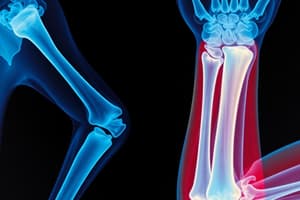Podcast
Questions and Answers
What is the appropriate patient position for an AP forearm radiograph?
What is the appropriate patient position for an AP forearm radiograph?
- Patient seated with hand extended and palm up (correct)
- Patient seated with arm adducted and elbow flexed
- Patient lying supine with arm across the chest
- Patient standing with arm down at their side
Which anatomical landmarks should be equidistant from the imaging receptor in a true AP forearm position?
Which anatomical landmarks should be equidistant from the imaging receptor in a true AP forearm position?
- Radial and ulnar styloid processes
- Capitate and trapezium bones
- Olecranon and coronoid processes
- Medial and lateral epicondyles of the humerus (correct)
What is the recommended exposure factor settings for a forearm radiograph?
What is the recommended exposure factor settings for a forearm radiograph?
- 75 kVp, 75 cm SID
- 60 kVp, 150 cm SID
- 60 kVp, 100 cm SID (correct)
- 70 kVp, 100 cm SID
What characterizes a Classic Galeazzi fracture?
What characterizes a Classic Galeazzi fracture?
What preparatory step is necessary for a patient presenting with an arm in a sling before a forearm radiograph?
What preparatory step is necessary for a patient presenting with an arm in a sling before a forearm radiograph?
What is one of the common clinical indications for performing radiography of the forearm?
What is one of the common clinical indications for performing radiography of the forearm?
Which anatomical point is located at the elbow joint during forearm radiography?
Which anatomical point is located at the elbow joint during forearm radiography?
What are the key considerations in patient preparation for forearm and elbow radiography?
What are the key considerations in patient preparation for forearm and elbow radiography?
What is the minimum number of projections required for a standard radiography of the elbow?
What is the minimum number of projections required for a standard radiography of the elbow?
Which pathology is NOT a common clinical indication for forearm radiography?
Which pathology is NOT a common clinical indication for forearm radiography?
Which radiographic technique is particularly important when performing forearm and elbow radiography?
Which radiographic technique is particularly important when performing forearm and elbow radiography?
In standard forearm radiography, which of the following projections is typically performed?
In standard forearm radiography, which of the following projections is typically performed?
When assessing for common fractures in the forearm, which type is often evaluated?
When assessing for common fractures in the forearm, which type is often evaluated?
What is a special consideration in patient positioning for forearm and elbow radiography?
What is a special consideration in patient positioning for forearm and elbow radiography?
What should be addressed when dealing with radiographic challenges in elbow imaging?
What should be addressed when dealing with radiographic challenges in elbow imaging?
Flashcards are hidden until you start studying
Study Notes
Classic Galeazzi Fracture
- Occurs at the junction of the middle and distal thirds of the radius
- Results in dislocation or subluxation of the distal radio-ulnar joint
Radiography of the Forearm: Standard Projections
- AP: Demonstrates the entire radius and ulna, proximal row of carpal bones, distal humerus, soft tissue (fat pads), elbow and wrist joints
- Lateral: Anatomy is demonstrated in the lateral position
Radiography of the Forearm: Technique
- Exposure factors:
- 60 kVp
- 100 cm SID/FFD
- Small focal spot
- Collimation: Both lateral borders, both ends, minimum of 3-4 cm distal to wrist and elbow joints included on the IR
Radiography of the Forearm: Patient Preparation
- Remove artifacts: clothing, sling, jewelry, roll up sleeves
- Radiation protection: Shielding outside the region of interest
Radiography of the Forearm: Patient Positioning (AP)
- Patient seated at the end of the table
- Hand extended and palm up (supinated)
- Arm is abducted and fully extended
- Shoulder, elbow, and wrist in the same plane
- Medial and lateral epicondyles equidistant from the cassette/IR
- CR perpendicular to the IR, directed to mid-forearm
Radiography of the Forearm: Essential Image Characteristics
- Long axis of forearm aligned to the long axis of the IR
- Elbow and wrist joints demonstrated on the IR
- Both joints in true AP position, with radial and ulnar styloid processes and epicondyles of the humerus equidistant from the IR
Radiography of the Forearm: Anatomical Points
- Head of radius is at the elbow
Radiography of the Elbow: Clinical Indications
- Common area of trauma
- Fractures:
- Supracondylar
- Condylar/epicondylar (lateral or medial)
- Radial head or neck
- Olecranon
- Dislocations
- Other:
- RSI (tennis or golfer's elbow)
- Tumors
Radiography of the Elbow: Patient Preparation
- Elbow injuries are painful, patients may be reluctant to extend the arm
- Never force an arm into position, demonstrate and encourage patient to position themselves
- Remove artifacts: clothing, sling
- Children: Dislocation or supracondylar fracture
- Adults: Radial head fracture or RSI
Radiography of the Elbow: Technique
- Need maximum recorded detail
- 60-70 kVp
- 100 cm SID/FFD
- Nongrid
Radiography of the Elbow: Protocols - Radiographic Projections
- Routine: 3-4 projections
- AP
- AP oblique lateral (external rotation): Primarily for injury of the radial head
Studying That Suits You
Use AI to generate personalized quizzes and flashcards to suit your learning preferences.




